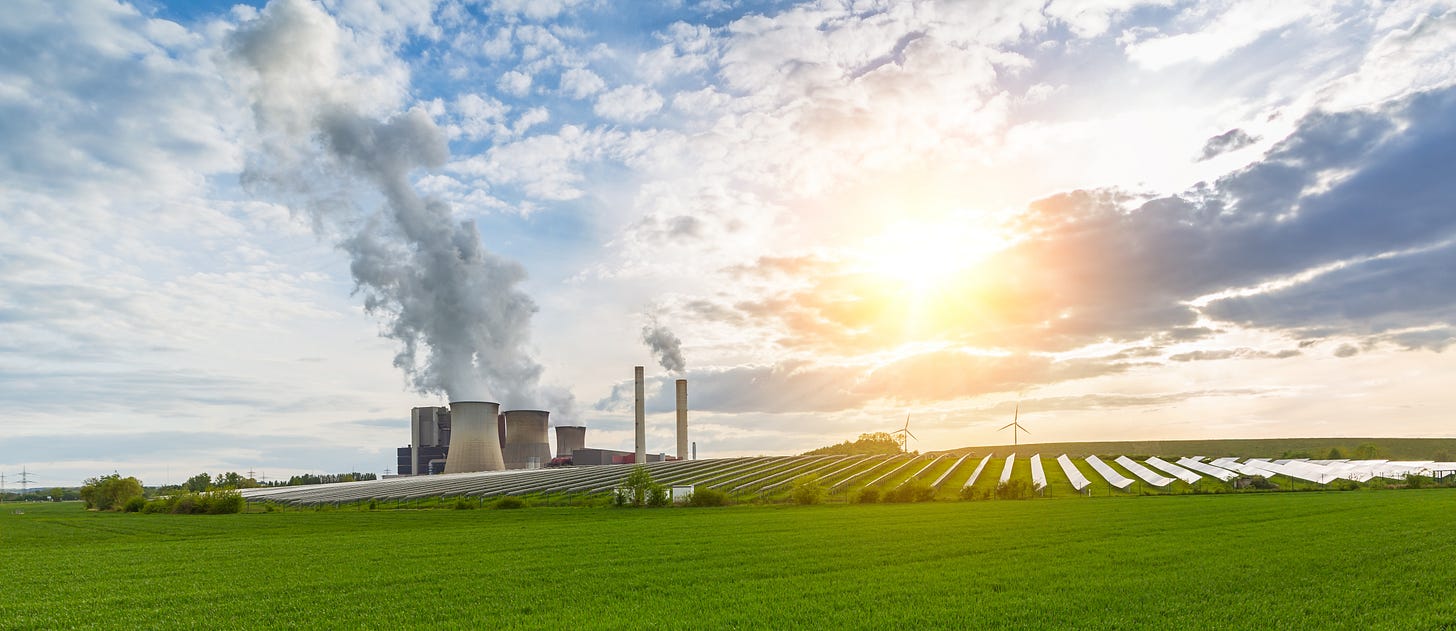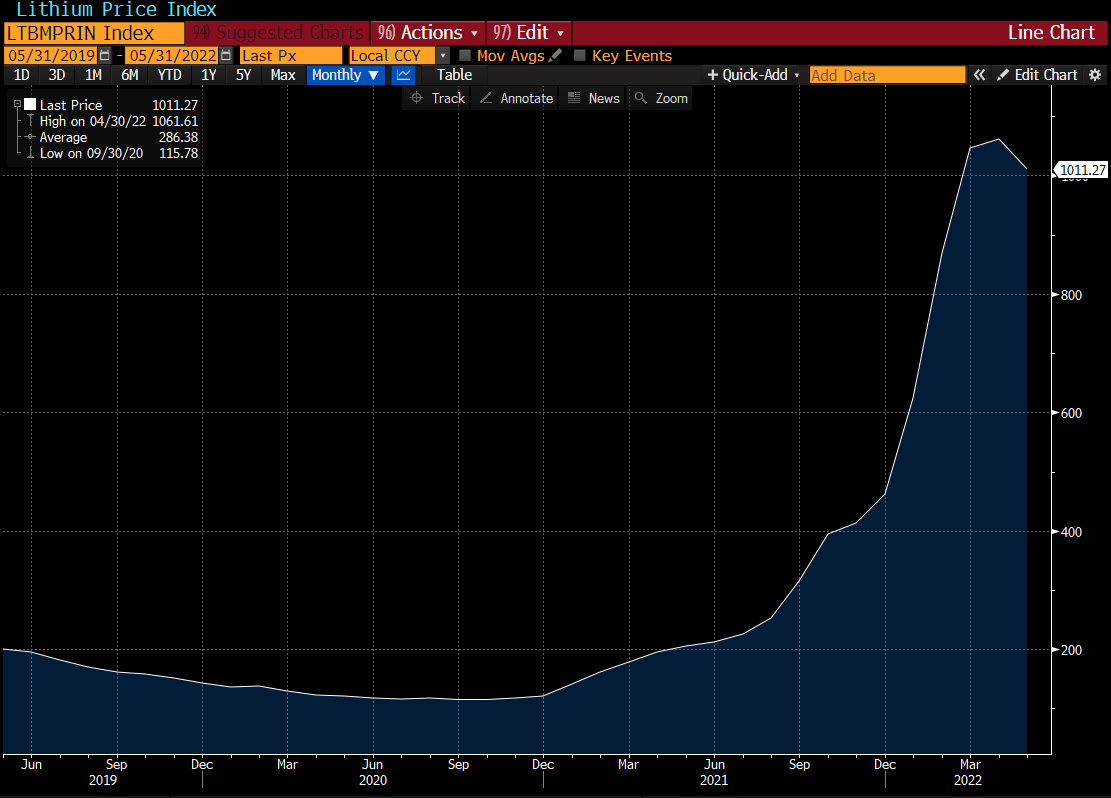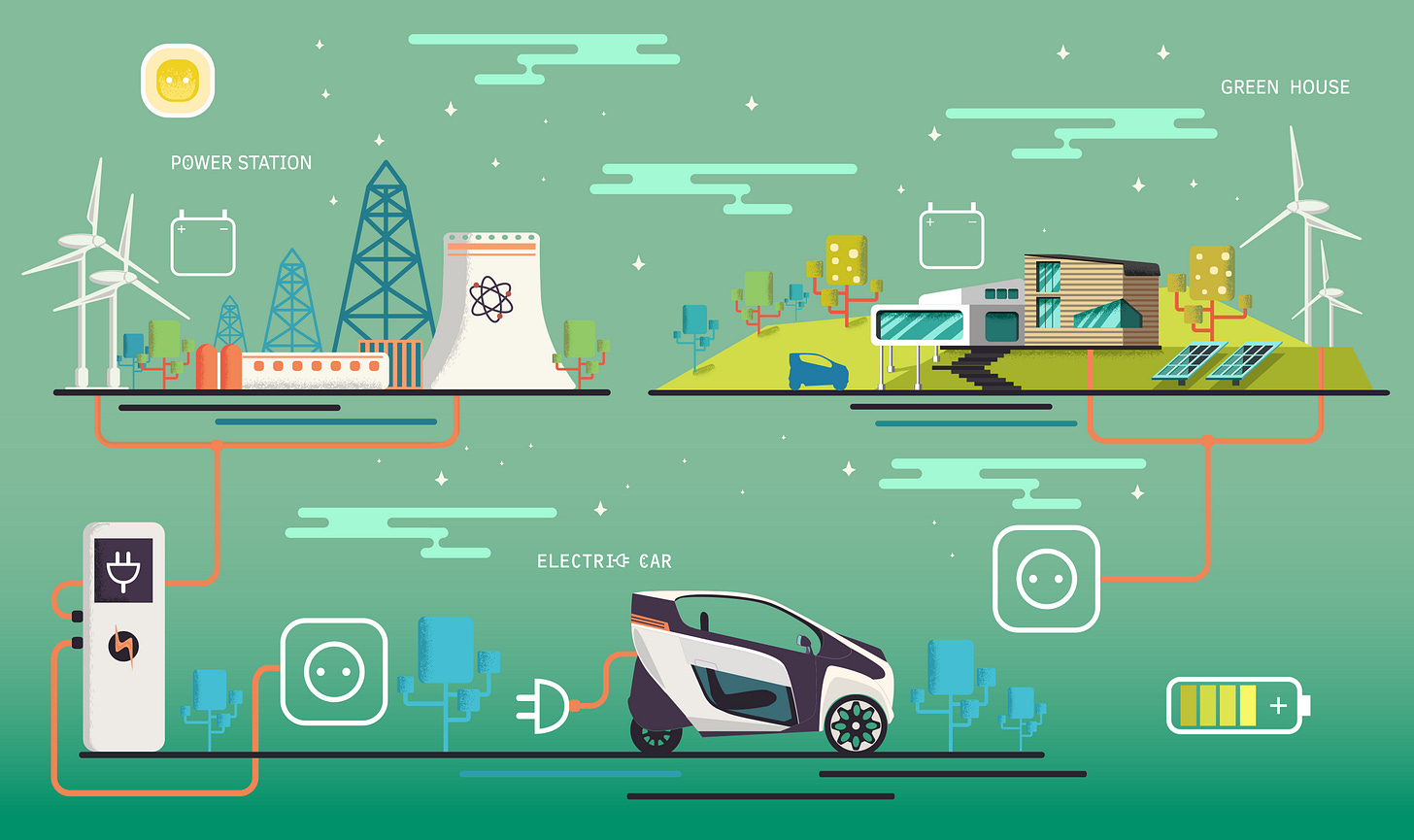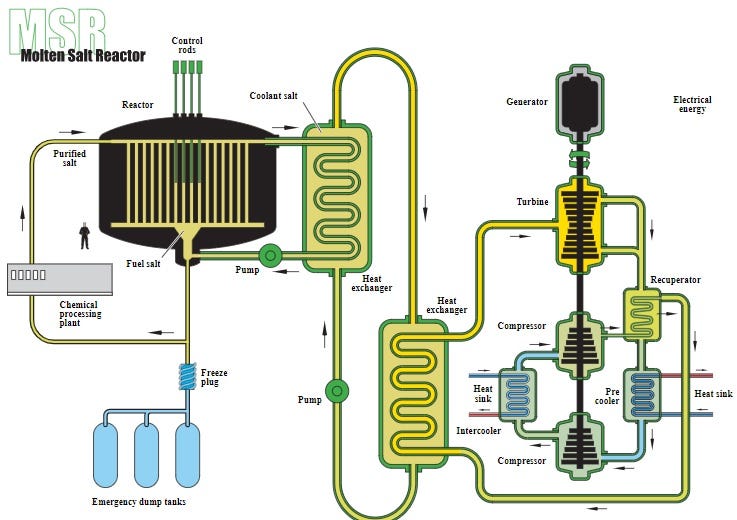Apocalypse (Still) Not Now
In The Ring - June 17th, 2022
Source: Shutterstock (r.classen)
“The result of the Biden Administration’s hostility toward the energy industry is skyrocketing inflation.“ - Michael Shellenberger, Career Climate Activist and Bestselling Author
Special message: The last seven trading days have been among the worst I’ve seen in my 43-year career. For the Haymaker’s take on how to deal with the chaos, please be sure to read the June 20th Making Hay Monday. In the meantime, it’s trite (but true) to point out that chaos creates opportunity.
Accountability and credibility: Those two words constitute this Haymaker’s core theme. As we all know, they rarely apply to our policymakers, including our omnipotent central bankers. However, I’m not going after the Fed for a change, even though it is sorely lacking in both of those traits.
What you are about to read gets very little media coverage and it’s also likely to light up my in-box with a barrage of flame-mails. It’s such an incendiary topic that I need to open with some disclaimers and clarifications.
First, I am a total believer in “Greenflation”. This is a term that, to the best of my knowledge, I first articulated (that’s my story and I’m sticking to it!). Yet, despite this conviction, I also hold that renewables have an important role to play in the increasingly urgent quest for energy sources. Yes, I know talk is cheap, but I’ll tell you what isn’t: installing a solar power system. In fact, it cost 50% more than the first home my wife and I bought in 1980!
Eventually, we’ll likely acquire an electric vehicle (EV) for trips around the Palm Springs area cities, which are pretty much the only places we go for about five months a year. As I wrote in the original Apocalypse Not Now (October 2019), that’s far better than charging off the grid which, in many cases, is still powered by fossil fuels, including coal. (In China, charging EVs is much more environmentally unfriendly due to the reality that about 60% of its electricity is generated by coal.)
To be clear, I’m not anti-fossil fuels, as anyone who has read my newsletters in recent years is well aware. Actually, it’s quite the contrary. However, I do feel that burning coal to produce electricity is highly deleterious to the atmosphere and human health. Ironically, the energy policies the world’s leaders have been increasingly pursuing over the last two decades have led to a surge in coal-based power, at least outside of the U.S. In America, coal’s share has steadily declined and has been offset by increased utilization of renewables and natural gas to provide electricity.
Returning to the concept of greenflation, about which I’ve been writing and talking since 2020, the basic idea is that for the first time in history humanity is moving away from more energy-dense sources — like oil, natural gas and nuclear — to less energy-dense sources such as wind and solar. (Here’s a link to a chapter of my book that we ran last November, in advance of its publication, on this topic.)
In addition to a relative lack of reliability, the green ecosystem (which requires fossil fuel back-up systems in many cases) is also heavily reliant on exceedingly scarce resources. The odds are very high that these are going to become even more scarce.
Previously, I pointed out that lithium prices have risen 1000% since 2019 and it is, of course, essential to EV batteries. The Renewable Energy Agency forecasts demand for lithium will rise tenfold this decade. Assuming they’re right, it’s mind-boggling to think what that will do to its price. But lithium is just one of the many critical green/EV inputs that is in extremely short supply.
Russia’s invasion of Ukraine has dramatically underscored Europe’s lack of energy self-sufficiency, mostly related to oil and natural gas. However, here’s a chilling factoid relative to its desire to predominantly shift to green energy: per the U.S. Geological Survey, 98% of its rare earth elements (REEs) are imported from China. REEs are, of course, critical inputs for a green energy-based system. Consequently, Europe is poised to jump from the Russian frying pan into the Chinese fire.
Like many countries in the West, including the U.S., Europe is shutting down a number of its nuclear power facilities. This is particularly true in Germany, but California may be headed that way as well with the potential closure of the Diablo Canyon Power Plant, a source of energy it desperately needs. In fact, the desperation has become so intense that even its anti-nuke governor, Gavin Newsom, is having second thoughts.
The belief among Western policymakers is that wind and solar can provide the majority of the world’s energy requirements. It’s my utter conviction they are as right about that as they were last year that inflation was transitory; or that pushing NATO to Russia’s borders wouldn’t provoke Vladimir Putin; or that negative yielding bonds and money printing would boost economic growth; or that Fed policies weren’t creating a monstrous bubble in U.S. financial markets. This is my credibility argument: based on their actions in many regards, they have very little.
To be LCD clear, I’m convinced Western governments are making an enormous mistake by excessively relying on renewables and ignoring harsh realities such as the aforementioned acute shortage of crucial green energy inputs. They are also blissfully ignorant of the fragility of the grid that needs to support millions of additional EVs, as well as the ferocious, borderline fanatical, opposition to new transmission lines. This is not to mention the almost universal hostility to building new solar and wind farms.
Source: Shutterstock (Dasha Denke)
Yet, decarbonizing is seen as simply a must-do because of the existential threat of climate change. Generally, that is viewed as minimizing the rise in the Earth’s temperatures due to, primarily, CO2 emissions. It’s another of my beliefs that most Americans assume CO2 is a pollutant, largely because of the unrelenting media coverage of its harmful effects. Yet, as any scientist knows, and even laypersons should be aware, CO2 is the stuff of life. Could there be too much of a good thing? Maybe, but that science is far from settled (which is true of so much science these days).
What is a reality is that burning coal is noxious – literally. Coal plants emit “NOx”, nitrogen oxides, as well as sulfur dioxides (SO2). These pollutants are totally unlike CO2; they truly harm people and contribute to nasty conditions such as acid rain and dangerous air quality. Yet producing electricity with coal is something the world is doing even more these days, including in Europe as it is increasingly cut off from Russian oil and gas.
Moving into the crux of the accountability and credibility theme is applying this to the powerful forces that have made a series of dystopian predictions over the last 50 years. The Global Warming Policy Forum (GWPF) has created a compendium that no other entity has complied, at least to my knowledge: a summary of some of the most apocalyptic climate forecasts of the last fifty years. By the way, in the U.S., “... from 1990 to 2017, emissions of air toxics declined by 74%”, per the EPA.)
Because there is so much to cover, I’ve put their findings in bullet-point form:
In the 1970s, there were widespread fears in the scientific community of a new ice age (not all were convinced, it should be noted).
In 1989 Noel Brown, director of the NY office of the UN Environment Program predicted:
-Entire nations could be wiped off the face of the Earth due to rising sea levels by 2000 if global warming was not reversed
- Coastal flooding and crop failures would produce mass migration of “eco-refugees”
- Sea levels would rise by up to three feet
- Shifting climate patterns would create a new Dust Bowl in America and those conditions would spread to Canada
- (In the interest of brevity, I’ve left out some of his other predictions which also failed to materialize.)Al Gore stated in 2006 that unless drastic measures were taken to inhibit greenhouse gases (GHG), the world would reach the point of no return within of 10 years.
Prince Charles warned in July 2009 that mankind had 96 months to save the planet.
The U.S. Pentagon issued a stunningly bleak report in 2004 on climate change:
- By 2007, powerful storms would overwhelm coastal barriers, leaving large sections of the Netherlands uninhabitable. Cities such as The Hague would need to be abandoned.
- Europe would be devastated by climate change; however, per the Pentagon, it would be, oddly, due to extreme global cooling, as weather patterns on the Continent became Siberia-like.
- Millions would be unable to grow crops due to climate change or rising sea levels. Rich regions such as the U.S. and Europe would become virtual fortresses to block out the mass influx of climate change victims.
- A “significant drop” in the planet’s ability to sustain its present population would play out over the next 20 years.
- Mega-droughts would imperil America’s midwestern breadbasket, with strong winds causing several soil loss.
- Bangladesh would become almost unlivable due to rising sea levels.In March 2000, Dr. David Viner, senior research scientist at the Climate Research Unit of the University of East Anglia (UK), opined that winter snowfall would become “a rare and exciting event. Children just aren’t going to know what snow is.” Yet, December 2010 was England’s coldest December in 100 years with multiple feet of snow. (As an updated footnote, in this case from the Pacific NW, Crystal Mountain ski area, outside of Seattle, stayed open until June 12th this year and still had an 81” base when it closed.)
Dr. Viner also declared in 2006 that the Mediterranean region would become too hot for vacationers within 20 years.
A Univ of Surrey (UK) climate research conference predicted that England would soon begin to experience a Mediterranean climate, leading to olive groves and vineyards; traditional English gardens would die off, replaced by palm and eucalyptus trees. In reality, British summers reman cool and often rainy and the hot summers of 1976 and 1995 have not recurred.
On the other side of the world, Australia’s Tim Flannery, Chief Commissioner of the Climate Commission, was convinced that it would run out of water back in 2004: “I think there is a fair chance Perth will be the 21st century’s first ghost metropolis,” he speculated.
In 2007, Mr. Flannery reiterated Armageddon: “Brisbane and Adelaide—home to a combined three million people—could run out of water by year’s end.” And then the rains came. By 2010, the dams around Brisbane, Canberra and Sydney were overflowing. (My note: 2022, thus far, has also been very wet in Australia, with widespread flooding.)
The director of the UN Environment Program forecast in 1989 that entire nations would be wiped off the face of the Earth due to rising sea levels by 2000 if warming trends not stopped.
In 1995, scientists from the UN’s Intergovernmental Panel on Climate Change (IPCC) warned that most U.S. east coast beaches would disappear in 25 years.
In 2007, Professor Wieslaw Maslowski stated that northern polar waters would be ice-free in the summers within 5 to 6 years. In December 2007, NASA’s Jay Zwally agreed, there would be no sea ice by the summer of 2012. In 2008, Prof. David Barber said sea ice would disappear in the summer that year. Yet, according to the European Union’s Copernicus Climate Change Service, sea ice during the summer of 2021 was well above the 2012 level. Moreover, end of winter sea ice coverage in 2021 was just 3% below the 30-year average.
James Hansen, the famous climate scientist then at NASA, claimed in 1988 that New York City’s West Side Highway would be underwater within 40 years. That leaves just six years to go for a lot of submerging to occur. Yet, according to a NOAA study, sea levels are rising no faster than a century ago.
To use a relevant analogy, the above is merely the tip of the iceberg when it comes to horrifying, and horribly inaccurate, climate catastrophe prognostications. Yet despite this pathetic track record, there has been almost no accountability. (If you’d like to see the full report which contains far more detail, it is accessible here.)
It’s unquestionable that humanity has inflicted serious environmental damage over the last century. Pollution needs to be addressed, as the U.S. has effectively done with air quality. But terrifying the planet’s populace with wildly inaccurate forecasts does more harm than good. People begin seeing through the dire predictions when their own experiences directly contradict them, shredding the credibility conferred upon them by a generally unquestioning media. For those who dare to challenge the apocalyptic narrative, the wrath is withering. In this, and many other ways, America has become “Condemn-nation”, at least for those who question the supposedly settled science.
Western voters are also aware enough to realize what China is doing with regard to global warming. During last year’s big climate change conference (COP 26), it lobbied for, and received approval to, avoid restrictions on fossil fuel use, including coal. In 2020, China opened 38.4 gigawatts of new coal-based generation, triple the new capacity added by the rest of the world. It also granted approval to 47 gigawatts of new coal power plants, three times the 2019 level. (A gigawatt powers one mid-sized city.)
India is also aggressively building out new coal power production capabilities, as are other Asian countries. Between China and India alone, that’s nearly 3 billion people whose governments are adding coal-fired generation at a blistering pace.
As noted on pages 1 and 2, China increasingly has the West by the short hairs when it comes to green energy. My good friend, who writes under the nom de plume of Doomberg, summed up the situation wonderfully earlier this week:
“Say what you will about the Chinese Communist Party (CCP), they routinely start any ‘game’ with the end in mind and maneuver their pieces accordingly. Over the past two decades, the CCP has obtained a virtual monopoly on the manufacture of all the key components of the solar power value chain. How successful have they been in this endeavor? For answers, we turn to a recent report from the US Department of Energy (DOE, emphasis added throughout):
‘As of 2021, China possessed 72% of the world’s polysilicon manufacturing capacity, 98% of ingots, 97% of wafers, 81% of cells, and 77% of modules. Seventy-five percent of the silicon solar cells incorporated into modules installed in the United States are produced by Chinese subsidiaries operating in three Southeast Asian countries: Vietnam, Malaysia, and Thailand.’”
It should also be pointed out that the use of the above referenced subsidiaries to evade U.S. fair-trade/anti-dumping laws is illegal. However, the U.S. solar industry has become heavily reliant on cheap Chinese solar panels, as indicated by Doomberg. Thus, the Biden administration is in a conflicted tough position, similar to its “I hate fossil fuels/We need more fossil fuels” stance.
As I vector to land this Haymaker — hopefully, on the smug chins of those policymakers who continue to spew platitudes while blithely ignoring physics — let’s consider a power source that has had a remarkable nearly 70-year run of producing safe and clear energy. To that point, have you ever wondered why the same technology that has run nuclear U.S. Navy subs and carriers since the 1950s can’t be used in other applications?
For some reason, the West, including the U.S., has focused primarily on massive-scale plants like Diablo Canyon. They are wonderful sources of abundant clean energy, but they are virtually unbuildable these days. In fact, it’s been that way for decades. They are just too expensive and prone to multi-year, if not multi-decade, delays. Two cases in point are Georgia Power’s Vogtle 3 and 4 nuke plants. They are six years behind schedule and 100% over budget ($30 billion vs $15 billion). These will be the first new nuclear generation facilities in the last 30 years and after this experience it’s hard to believe any others will be attempted.
Spent-fuel disposal is also a major problem, particularly since the late Nevada Senator Harry Reid successfully blocked the utilization of the Yucca Mountain Waste Nuclear Repository site. (The General Accountability Office has stated its usage was halted for political, not safety, reasons.)
Source: Shutterstock (DesignRage)
Previously, I’ve written about the appeal of small-modular nuclear reactors. In recent months, I’ve become a supporter of a company with very promising technology in that regard, MicroNuclear, LLC. Thus far, I am not an investor, and my assistance has mainly been in the way of introductions.
Quoting one of the world’s foremost authorities on naval nuclear propulsion, Richard McPherson, CEO of MicroNuclear’s Idaho Energy, Inc., subsidiary: “It took just 4 years and 3 months to complete the U.S. Navy’s first nuclear power plant design. Nautilus operated for about 25 years. The first prototype was in service for about 13 years until it was modified to be a S5W plant. It was shut down on October 17, 1989, after 36-years of service. The S5W plant became the design that powered the most submarines to date. The U.S. Naval nuclear propulsion program is the largest and most complex industrial undertaking ever. Naval Reactors has a staff of about 400 people, with a cradle to grave responsibility. Compare that size staff to the Nuclear Regulatory Commission (NRC) with a staff of about 3,000 at its headquarters, with no such responsibilities.”
Source: U.S. Department of Energy via Wikimedia Commons
MicroNuclear has adapted and updated this technology to create a Molten Salt Nuclear Reactor/Battery prototype. (MSNR/B) It has built on the process first developed in the early 1960s at Oak Ridge, Tennessee. It intends to deliver functional reactors as soon as next year.
A key advantage MSNR/Bs offer is that after the roughly decade-long life of their fuel, it can be reused. Consequently, one of the biggest objections to nuclear power is rendered moot. Additionally, there is virtually no chance of a meltdown or radiation leak.
Obviously, MicroNuclear may not succeed. It’s a super high-risk, super high-reward, effort. Yet, based on what Richard and other members of his team have done over the decades with naval nuclear propulsion, and other nuclear power projects, it is far from pie-in-the-sky. Regardless of the specific technology, it seems to me making an Apollo program type of effort around small modular reactors, molten salt or otherwise, is a much more rational solution to limiting greenhouse gases while avoiding the kind of economic holocaust with which the present transition is flirting.
It would also avoid the unilateral energy disarmament I’ve been warning about that only makes us weaker and our geopolitical adversaries stronger. Becoming beholden to China to supply our energy needs strikes me as tantamount to being relegated to vassal state status. In my mind, that’s a far greater threat to life as we know it than CO2.
A Word From The Haymaker’s Corner
Our readers have been helping out greatly with plenty of “Likes” and insightful commentary on our work. We thank you for that and will always eagerly check out what you have to say. And if you’re loving the Haymaker’s content enough to regularly visit us ringside, we invite you to become a subscriber (if you aren’t one already) and hope you’ll share the content with any friends who might enjoy weekly thoughts on markets, banks, commodities, politics, and more.
There’s that bell once again. The fight continues.
(Note: Post updated to include select stock photo details, per new convention)







I wish MicroNuclear success… And the opposite to the CCP.
David,
Thanks for all that you do. I really enjoy being educated by the Haymaker.